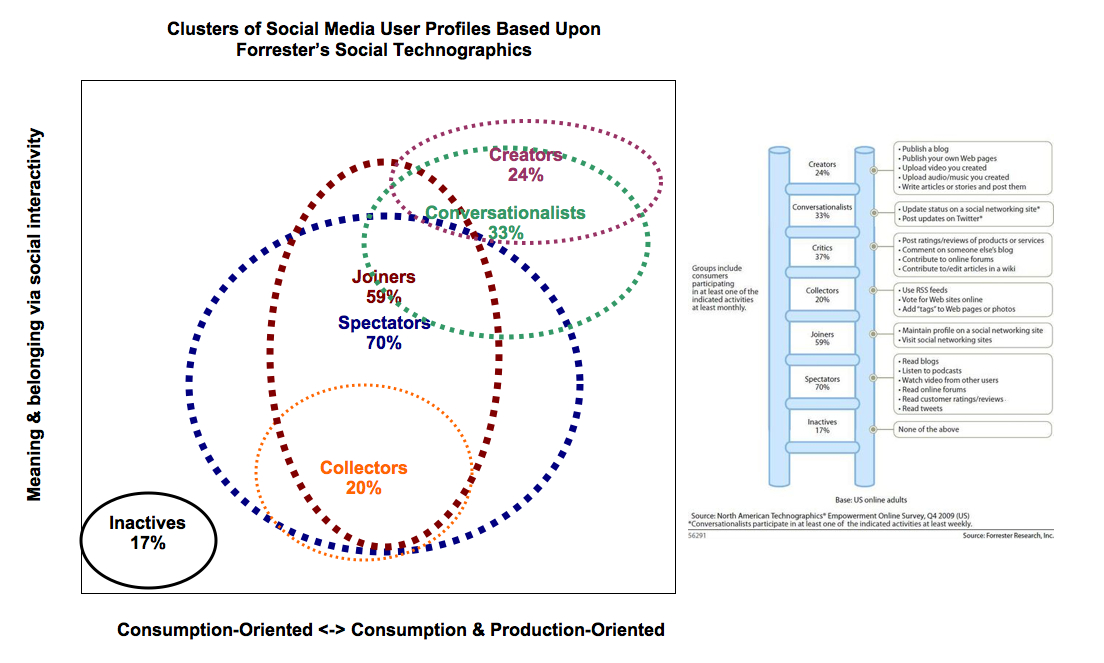
I’ve always been interested by Forrester’s work on social technographics {click on this link to see the Forrester categories defined}, but I’ve been interested in extending these ideas by incorporating concepts like identity, sense of belonging, and meaning, as they relate to online social interactions. While social technographics creates a one-dimensional hierarchical “ladder” along a continuum of passive consumption to interactive consumption and production of content, I’m interested in added dimensions of::
- How the social construction of relations we have affects our use of social media, as they relate to our identity and the meanings we derive from our online interactions.
- How a sense of community or belonging shapes our use of social media.
I think these are fundamental human activities, i.e., finding meaning and belonging to a “community” {broadly defined}. The diagram I created above explores the idea of how social processes may affect technological engagement with social media and content. It’s clearly not meant to be a definitive model, but the idea is that the greater the meaning an activity has, the more the activity fosters one’s identity, and/or the more an activity fosters a sense of belonging or community, the greater the interactivity with social media, in terms of consumption and production of content. In the diagram, the boundaries are meant to be fuzzy and the percentages sum to over 100% because the profiles overlap. The Forrester profile groupings are based upon “participating in at least one of the indicated activities at least monthly” [1]. Addressing the interplay between 1 & 2 listed above would advance social science theory {e.g., symbolic interactionism [2] and sense of community [3]} and practice {from marketing to civic engagement} through the understanding of everyday online interactions within the context of social structures like groups/communities.
I see many of these clusterings of activities, distinguished from being characteristics of individuals, as non-hierarchical. I will say I haven’t seen what’s behind Forrester’s paywall, which may addresss this, as well as my sociological interests. That said, I would hazard to guess that over time {as social media diffuses} there are a certain percentage of users who engage in “spectator” and/or “joiner” behaviours who are content to do just those activities. I’m not sure that there are that many who are or will ever be interested in “creator” activity. My hunch is that those interested in “creator” activity won’t go much higher than 20%, along the lines of the 80/20 rule.
Nevertheless, I view social technographics as a useful concept and in my applied work, I’m interested in the specifics of online community and how they relate to online and offline actions.
Twitterversion:: New & interesting @Forrester research on social technographics.My graph ponders how social psych/sociology may shape this http://url.ie/4pxm @Prof_K
Song:: Weezer-“Pork and Beans”
References::
[1] Bernoff, Josh {2010} “Social Technographics: Conversationalists get onto the ladder”. Groundswell, Forrester Research, Inc. http://blogs.forrester.com/groundswell/2010/01/conversationalists-get-onto-the-ladder.html
[2] McClelland, Kent {2000} “SYMBOLIC INTERACTIONISM”. Grinnell College, Theoretical Perspectives in Sociology. http://web.grinnell.edu/courses/soc/s00/soc111-01/introtheories/symbolic.html
[3] University of Maryland Baltimore County, PROMISE-Alliance for Graduate Education and the Professoriate. “Psychological Sense of Community: Theory of McMillan & Chavis (1986)” http://www.umbc.edu/promise/documents/Community,%20Psychology,%20Psychological,%20Sense%20of%20Community%20Theory%20of%20McMillan,%20Chavis%201986.htm

Comments